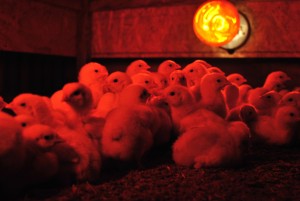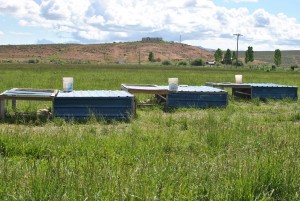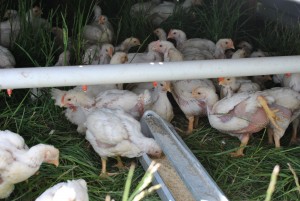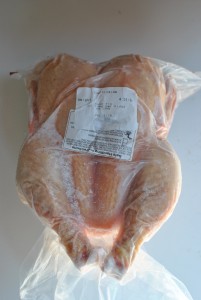This was the first year we tried raising Cornish Cross chickens for our customers. To say that it was a success, would be an overstatement, but to say it was a total failure would be… Well, almost correct, but it was not a complete loss, we at least broke even, but in a business, “breaking even” is not quite what you are aiming for.
The first batch of chickens we started with 200 chicks and ended up with 107 successfully making it to harvest. The second batch of chickens we started with 200 chicks and ended up with 134 successfully making it to harvest.
A little background on Cornish Cross chickens will give you a little bit of a better idea why they are so difficult to raise. Cornish Cross chickens were developed for confinement chicken houses, they are designed to be on a steady diet of antibiotics, have a perfect temperature at all times and have the perfect protein ration diet. By 8 weeks of age they go from weighing almost nothing to an 8-10 lb chicken that develops heart and leg problems due to the unnatural rate of growth in that time.
Now you are probably wonder why we even tried raising these birds in particular and not go with another breed. Well, there is literally no other breed that gives you that much return in such a short period of time. They are also double breasted bird, which means their breast as twice the size of any other chicken, this is the chicken you buy at the supermarket, and no one is used to the “old style” thin breasted chicken anymore. All other breeds of chickens take at least 12-16 weeks to get to full size and their full size is typically 5-7 lbs and dress out at 2-3 lbs, compared to the Cornish Cross which will dress out at 8 weeks between 4-6 lbs. If you let them go for a few more weeks they can dress out close to 8-11 lbs (hello, small turkey?)
Obviously, with a bird that gains so much in such a short period of time, there’s bound to be problems, and we discovered almost all of them. These birds do not handle outside stresses like a standard chicken does, so temperature fluctuations, timing in feeding and the amount of chickens in space can affect their growth.
We bought our first batch way too early. They were in a brooder in our shop, but we think since they were in a smaller confined area, it was too cold for little chicks. Drafts were not an issue, but just the air in general was very chilly. We lost around 30 chicks in the first 3 weeks in the brooder.

By the 3-4th week the chicks we getting big and the brooder was difficult to keep clean, so we decided to turn them out in the movable pens. However, it was clearly way too cold at night (we live at 4000 ft elevation, so it gets very cold at night). These chickens do not handle temperature swings well. If it was 70 during the day, it would be around freezing at night. Remember, most people raise these chickens in confinement housing their entire life so they can’t handle unstable temperatures. Chicks started dying all over, so we put heat lamps in and turned them on at night. Well, then they would all gather together under the heat lamp and several would get suffocated in the night. At this point we did not have enough space to put them back inside, they had to make it outside at this time.

Every night my husband would go out and put a piece of cardboard over the entrance of their movable coop so they would stay in and keep warm. Eventually their deaths started to slow down, but we consistently lost 1-2 chickens a night. When we brought them to chicken processing the owners suggested that we probably lost most of our birds due to a disease called “water belly.” Sure enough, it sounded like that was the problem with them, the main cause? Temperature fluctuations and elevations over 3000 ft. At higher elevations available oxygen is lower, and these birds are known for respiratory problems, so thinner air is very difficult on them.
The second batch of chicks had difficultly at first as well, due to the cold temperatures, but it warmed up by the time we needed to turn them outside and it wasn’t freezing anymore at night. It was amazing how much better they did outside. We maybe lost a total of 5 chickens from the time we turned them outside, compared to losing 1-2 every day with our first batch. So, we learned the warmer temperatures are critical for these chickens. However, on the other end, they do not do well in temperatures over 85 degrees, so we are thankful that our chickens were processed this last week when it was still in the 80’s compared to this week which is scheduled to be in the 100’s.

Pasture raised chickens are so much healthier for the birds and for those consuming them, but since they are not necessarily designed for outside lifestyle you must factor in death loss and difficulties that those who raise them inside do not have to deal with.
Will we raise them again? Well, it’ll depend on whether we can get someone at lower elevation to raise them for us, because it is very difficult to successfully raise them at 4000 ft elevation, and when the weather is good to raise them, it’s a short period of time before it becomes too hot.

Well, they were very tasty…
What about raising a heartier breed. I personally don’t care if they are large breasted. 🙂
Hi – Thanks for sharing your story. We raised Cornish x for the first time, too, tho we are experienced with laying hens and chicks. We only did a small batch of 16 meat chickens.. We got them the first week of April, but they were already 5-6 days old and discounted at TSC. This gave us an edge, because so many die in the first week. We lost one due to an leg problem about 4 weeks of age. We live at 3400′. It’s been in the 90’s during the day and was very cold at night till about 2 weeks ago. We brooded them in a coop (nice closed building) and let them out to free range during the day. They didn’t want to go out, but each day we gently encouraged them to at least go out and sit in the cool grass. Today we processed 15 birds. The males dressed out and 6.5-7.5 pounds and the females at 5.5-6.5 pounds. We calculated they whole dressed roasters cost us $1.17 per pound. YaY! We learned a lot and will do them again next year, but maybe 30-40 chicks. We have 5 turkeys (first time) and am excited to see the end results in October.
Until chicken have feathers they are unable to regulate body heat. You clearly had an inadequate brooder set up and prematurely put the birds out before they were ready…also you need to consider your climate. Sounds like you started these chicks WAY too early. CX Broilers are NOT that difficult to raise.
Actually we were doing them in May, which if you do them any later than that then it gets too hot when they get too big. We live at 4000 ft elevation and they do not do well up here due to less oxygen. We know for our area they are not the best chickens to raise. We have been raising laying hens and red rangers for years and never have any issues, but Cornish X are just too fragile for our particular location. I have a guy who raises them for us at 1200 ft elevation and he has no issues raising them.